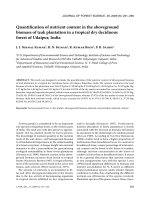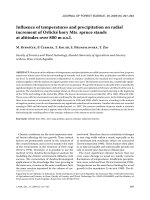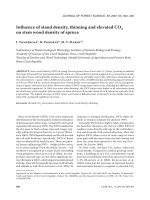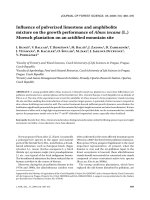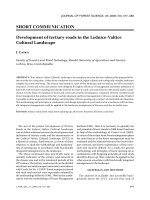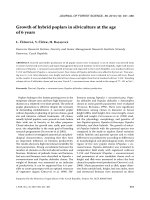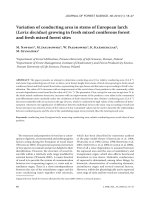Báo cáo lâm nghiệp: "Influence of light conditions on the predetermination of foliar characteristics in Betula alleghaniensis Britton" ppsx
Bạn đang xem bản rút gọn của tài liệu. Xem và tải ngay bản đầy đủ của tài liệu tại đây (394.53 KB, 5 trang )
Influence
of
light
conditions
on
the
predetermination
of
foliar
characteristics
in
Betula
alleghaniensis
Britton
M.
Labrecque
1
P.
Bellefleur
2
J.P.
Simon
3
S. Popovich
4
1
Jardin
Botanique
de
la
Ville
de
Montréal,
4101
est,
rue
Sherbrooke,
Montréal,
Qc,
H 1X 2B2,
2
Facult6
de
Foresterie
et
G6od6sie,
Universit6
Laval,
Ste-Foy,
Qc,
G1K
7P4,
3
D6partement
des
Sciences
Biologiques,
Université
de
Montr6al,
Montr6al,
Qc,
H3C
3J7,
and
4
Centre
de
Foresterie
des
Laurentides,
For6ts
Canada,
C.P.
3800,
Ste-Foy,
Qc,
G1 V 4C7,
Canada
Introduction
Several
studies
have
shown
that
the
mor-
phology
and
physiological
processes
of
leaves
are
largely
influenced
by
light
conditions
in
the
environment.
However,
little
is
known
about
the
importance
of
light
conditions
during
the
previous
year
on
the
development
of
leaves
the
following
spring.
A
few
researchers
have
reported
contradictory
information.
Isanogle
(1944),
Cormack
and
Gorham
(1953)
and,
more
recently,
Goulet
and
Bellefleur
(1986)
found
that
light
intensity
before
leaf
expan-
sion
was
not
important
in
determining
leaf
characteristics
and
that
leaf
expression
was
not
predetermined
in
the
bud.
Other
reports
concluded
that
the
anatomical
and
physiological
characteristics
of
early
leaves
(preformed
in
the
winter
buds,
which
emerge
shortly
after
bud
break)
are
primarily
determined
by
the
light
condi-
tions
prevailing
during
the
previous
growth
season
(Hansen,
1959;
Roy
et al.,
1986).
The
objective
of
this
study
was
to
deter-
mine
the
effect
of
various
light
treatments
applied
during
one
growth
season,
on
the
morphology
and
chlorophyll
content
of
leaves
developing
during
the
following
year.
The
study
was
conducted
with
re-
forestation
in
mind
and
takes
into
account
the
problem
of
changes
in
light
conditions
which
seedlings
grown
in
the
nursery
for
1
or
2
seasons
are
subjected
to
when
plant-
ed.
Materials
and
Methods
During
one
growth
season
(n),
50
seedlings
of
yellow
birch
(Betula
alleghaniensis
Britton)
(1
+
0)
were
grown
outdoors
in
1
I pots
in
full
sun
condition
(FSC),
while
50
others
were
shaded
so
as
to
receive
25%
of
full
daylight
(SC).
Be-
fore
the
beginning
of
the
following
growth
sea-
son
(n
+
1
seedlings
from
each
group
were
split
into
2
lots
so
as
to
constitute
4
types
of
treatments
as
shown
in
Table
I.
Early
and
late
leaf
samples
were
harvested
randomly
from
the
seedlings
during
year
n
+
1.
Early
leaves
were
taken
from
the
basis
of
long
shoots,
1
and
4
wk
after
leafing-out.
New
fully
expanded
late
leaves
were
harvested
twice,
early
in
July
and
in
mid-August.
The
following
data
were
compared
for
each
sample:
1)
specific
leaf
area
(SLA,
mg
of
dry
weight
per
cm
2
);
2)
proportion
of
leaf
tissue
(using
a
stereological
procedure
similar
to
that
used
by
Chabot and
Chabot
(1977));
and
3)
chlorophyll
content
(a
+
b),
expressed
on
the
basis
of
leaf
area
and
dry
weight.
All
data
were
subjected
to
variance
analysis,
quoted
signifi-
cance
levels
are
at
P:50.05.
Results
Leaf
structure
SLA
values
calculated
for
early
and
late
leaves
which
developed
during
year
n
+
1
are
given
in
Table
II.
They
were
generally
higher
for
leaves
which
developed
in
full
sun.
However,
under
each
type
of
experi-
mental
condition
during
year
n
+
1,
a
clear
influence
of
the
light
treatment
of
the
pre-
vious
year
(n,l
was
observed.
Under
the
same
conditions,
SLA
values
were
signifi-
cantly
different
for
early
leaves
harvested
at
the
beginning
of
the
season.
Leaves
which
developed
on
seedlings
which
were
exposed
to
full
sun
conditions
during
year
n
had
proportionally
higher
values
than
those
grown
in
shaded
conditions
during
year
n.
Differences
exhibited
by
early
leaves
subsidetd
a
little
as
the
growth
sea-
son
progressed
but
can
still
be
observed
after
4
wk
(Table
II).
In
late
leaves,
the
influence
of
light
conditions
of
the
previous
year
was
not
observed
(Table
II).
Leaf anatomy
Table
III
summarizes
data
on
anatomical
features.
The
method
we
used
allowed
comparison
of
the
percentages
of
tissue
volumes
and
air
spaces
in
the
leaf
samples.
In
ec!rty
leaves,
palisade
tissue
and,
to
a
greater
extent,
the
volume
of
air
spaces
seem
to
have
been
most
affected
by
changes
in
the
light
conditions.
For
treatments
1
and
3
(Table
I),
leaves
had
proportionally
more
palisade
tissue
and
fewer
air
spaces
than
those
subjected
to
treatments
2
and
4
(Tables
I
and
III).
The
spongy
mesophyll
exhibited
few
variations
with
respect
to
the various
treatments.
A
,
,
proportion
of
air
spaces
was
also
observed
in
late
leaf
samples
harvested
in
early
July
on
seedlings
of
treatments
2
and
4,
but
these
differences
were
not
observed
in
leaves
harvested
in
mid-
August.
Chlorophyll
content
The
chlorophyll
content
of
early
leaves
was
also
influenced
by
the
light
conditions
of
year
n
(Fig.
1
For
the
1 st
harvest
of
early
leaves,
the
highest
values,
especial-
ly
when
expressed
on
the basis
of
dry
weight,
were
found
in
leaves
harvested
on
seedlings
of
treatments
2
and
4.
Dif-
ferences
were
less
noticeable
in
early
leaves
harvested
later,
and
were
no
longer
significant
in
late
leaves.
Discussion
All
analyzed
characteristics
(structure,
anatomy
and
chlorophyll
content)
agree
and
demonstrate
that
the
light
conditions
to
which
plants
have
been
exposed
have
an
influence
on
the
development
of
early
leaves
the
following
spring.
The
conse-
quences
on
anatomy
and,
notably,
on
number
of
air
spaces
are
evident.
Further-
more,
this
explains
why
specific
leaf
area
for
seedlings
grown
under
shade
condi-
tions
during
year
n
were
not
as
important.
Our
results
coincide
with
those
of
Roy
et
al.
(1986)
but
are
not
inconsistent
with
those
of
Goulet
and
Bellefleur
(1986)
and
Cormack
and
Gorham
(1953),
since
we
demonstrate
that,
as
the
season
pro-
gressed,
the
e;arly
leaves
were
more
and
more
influenced
by
the
light
conditions
in
their
new
environment.
Similarly,
late
leaves
seemed
to
be
influenced
only
by
current
year
light
conditions.
Acknowledgments
We
thank
Chantal
Martin
for
her
technical
assistance.
This
project
was
supported
by
the
GRDE
of
Canada.
References
Chabot
B.F.
&
Chabot
J.F.
(1977)
Effects
of
light
and
temperature
on
leaf
anatomy
and
photo-
synthesis
in
Fragaria
vesca.
Oecologia
(Berlin)
26, 363-377
Cormack
R.G.H.
&
Gorham
A.L.
(1953)
Effects
of
exposure
to
direct
sunlight
upon
the
develop-
ment
of
leaf
structure
of
two
deciduous
shrub
species.
Can.
J.
Bot
31,
537-541
Goulet
F.
&
Bellefleur
P.
(1986)
Leaf
morphology
plasticity
in
response
to
light
environment
in
de-
ciduous
tree
species
and
its
implication
on
forest
succession.
Can.
J.
For.
Res.
16, 1192-1195
Hansen
H.C.
(1959)
Der
einfluss
des
litchtes
auf
die
bildung
von
licht
und
schattenblattern
der
buche,
Fagus
sylvatica.
Physiol.
Plant.
12,
545-550
lsanogle
LT.
(1944)
Effects
of
controlled
shad-
ing
upon
the
development
of
leaf
structure
in
two
deciduous
tree
species.
Ecology
25,
404-
413
Roy
J.,
Thiebaut
B.
&
Watson
M.A.
(1986)
Phy-
siological
and
anatomical
consequences
of
morphogenetic
polymorphism:
leaf
response
to
light
intensity
in
young
beech
trees
(Fagus
syl-
vatica
L.).
Coll.
lnt.
sur
IArbre,
9-14
Sept.
1985,
Montpellier.
Nat
Monsp.
H.S.
431-449


